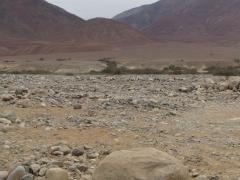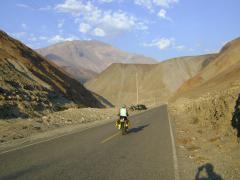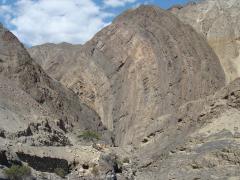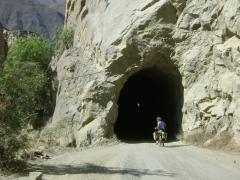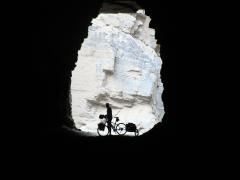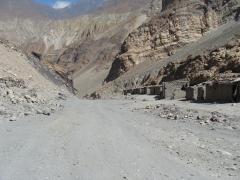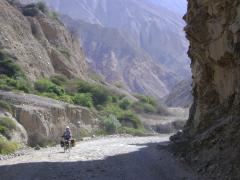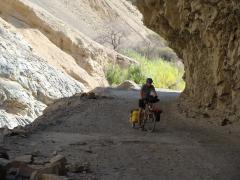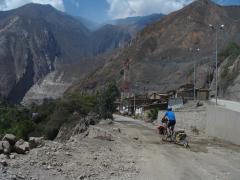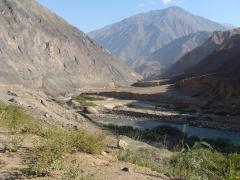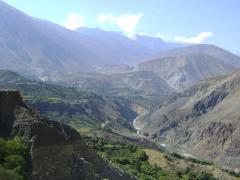Back on the road, Climbing up into the mountains
Click here for all of our favorite photos from this section
After more than three weeks of not riding we are back on the road once again in Peru. We made a two-week trip back to the United States to see all our family members and are glad to report all are well. It was good to see the family as well it was a delight to see all our wonderful friends.
We returned to Trujillo, Peru and stayed once again at the Casa de Ciclistas where Lucho and his family have offered free hospitality to cyclist for 23 years. Randy and I were visitor 998. While staying there, we meet 7 different cyclists from all over the world.
We have now been on the road for 5 days and are taking a rest day in Caraz. The ride from the coast up to Caraz has been amazing, spectacular, a hard ride on mostly dirt road, some good and some awful. The best part is the lack of traffic which permitted us to enjoy the majestic views of the mountains and the river valley we pedalled through.
We rode for one day on the Panamerican highway south to Chao. The road had a good shoulder, big trucks and a landscape which brought to mind the sand dunes of Saudi Arabia. Huge hills, not really mountains, of nothing but sand dunes. Nothing lived in this region, no houses, no people, no business thrived, no birds chirped, no butterfly fluttered by. Nada!The road followed the shoreline that stayed to our right some mile or two away. Only big trucks and buses whizzed by coming or going along this void coastal highway.
After spending the night in the dusty town of Chao we headed south for 15 kilometers and turned left onto a private road. The entrance to road was gated and guarded but we were permitted to proceed. The road was built as a service road for an irrigation plant. Cyclists are permitted to travel this road for free. The first part of this 36 kilometer road was eerie. The flat valley changed from sand dunes to lava beds of differing colors. As in a special Japanese garden, small purple rocks covered miles of this spreading valley, and then grey beds of grey rocks and other of green rocks stretched out in separate areas. Sand dunes morphed into mountains of flaming colors.
Almost daily, we stop and take a rest. We lay out our space blanket and lay down to stretch. As soon as we laid down, Randy fell asleep. As I lay there I noticed the silence. Except for Randy's steady breathing, I heard nothing. No wind, no birds, no insects, no cars, or planes or sounds of water moving. I had never heard complete silence before. I was scared. It was creepy to hear nothing. All this was to strange for me so I put on my headphones to listen to my music, to block out the silence. After two minutes of music, I thought how nuts this was and I put away my fears and music and listened to the silences. I soon noticed I smelled nothing. The air around was void of smell. Where there is not life there is not smell. So I sat and enjoyed the silence and the lack of smell of this strange and enchanting place.
The second day out of Trujillo was another day of eye candy. Mountains with morphing colors and molted formation surrounded this magic valley. We saw less than a dozen vehicles all day. We rode with our mouths wide open as we gawked at the wondrous landscape we slowly pedaled through. We rode through 12 tunnels cut right into the rocks. Some were short enough not to require a light, but the longer tunnels were pitch black. Using our headlamps we rode through the tunnels on the rutted surface with just enough light to crawl through and not wipe out. I worked hard to keep my line straight and not curve too much up and back in the rutted banks.
We stopped for lunch in the shade of an abandoned building. While I made tuna sandwiches, Randy slept again. We could not get our energy going so after our lunch and naps. So as Randy fixed some coffee on our little stove, I napped. This helped the slows but not enough so I looked for the Coca leaves I bought at the local market in Trijullo. I could not find it. But right next to our bikes, we spotted a different bag of coca leaves. Roadkill. I am always amazed on how we are provided for in our time of need. I tried a pinch and it was coca but was fresher and better than the coca I bought in the market. We both took a little wade and stuck it in our checks and continued on. Just the perfect remedy for the slows.
Here in Peru, coca leaves are chewed by many people. In the developed world, when you need a pick-me up, you may get a cup of coffee, tea, cola or chocolate. Here in South America they chew coca leaves or have a cup of coca tea for a legal pick-me up. To help us with the high elevation and to fight altitude sickness we decided to try this traditional medicine used by South Americans for thousands of years. What chewing coca leaves or having coca tea does is increase the oxygen in the blood, fight off fatigue, thirst and hunger. We will be living and riding for several months at elevations between 10,000 ft and 16,000 feet. I get elevation sickness at 8500ft, so I hope it gives me the natural assist to make living at those elevation more comfortable. By the way coca tea can be purchase in the United States. (No, don't worry about us. Although cocaine is made out of a highly refined paste made from coca leaves, chewing the coca leaf has nothing to do with cocaine.)
For the next two days we rode through the canyons and through the tunnels. We camped two nights, one at a gas station in a town of 100 people and another night at a mango orchard by an irrigation ditch. It was the first time I ever bathed in irrigation water and it felt wonderful. We rode our bikes through the famous Cañon del Pato and through 35 more tunnels. I will let the pictures tell the rest of the story.
On the fifth day we rested in the quiet town of Caraz, nestled beneath the Cordillera Blanca mountain range. We started the morning with a trip around the plaza to view the surrounding mountains in hope to see Huascaran, the highest mountain in Peru at 22,000ft (6,768 m).. Like a knife it slices the heavens with its diamond-sharp snow-covered peaks. We followed our grumbling stomachs to the best pastry store. The town is known as the town of sweets, Caraz Dulzura. It was both delightful and decadent to share a caramel custard, two apple-filled strudels and a pastry rolled in coconut and manjar, a milk and honey like substance. The coffee they make here is called Essencia, a thick brewed coffee poured into a large glass of steaming milk. We then proceeded to the local archaeological site, Tumshukaiko, a partially excavated 3000-year old ruin. Not very exciting. The dogs barking at us as we where leaving was the most exciting part. Randy headed to the internet cafe and I headed to the market to buy some food. I roamed the market studying people. I stopped and talked to the lady who makes hand-braided ropes. She learned this from her parents and her daughter learned it from her. The price of 6 feet of hand-braided rope about 60 cents for 6 feet. As she worked, her daughter and grandchild joined her at the street stall. In Peruvian style her daughter asked me dozens of questions about where I came from and our trip. Her 10 month son just stared at me with the biggest blackest almond eye. He did not blink, just sat and stared not moving for the ten minutes during my whole visit with the family. Those eyes are burnt into my sole for ever.
The people of Peru are friendly, generous and curious people. They are not afraid and are not self absorbed. It feels good to be here.

